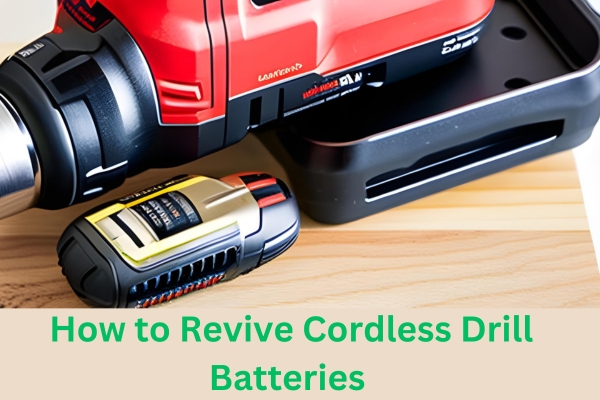Nowadays, cordless drills are indispensable tools for professionals and DIY enthusiasts alike. They offer convenience and flexibility, allowing you to work in various settings without being tethered to an electrical outlet. However, the one drawback that often plagues cordless drills is the lifespan of their batteries. Over time, these batteries can lose their capacity and effectiveness, leading to frustration for users. But fear not, as we’re about to delve into a comprehensive guide on how to revive cordless drill batteries and extend their life, saving you money and reducing waste.
How to Revive Cordless Drill Batteries: A Comprehensive Guide

Understanding Cordless Drill Batteries
Before we jump into the revival process, it’s crucial to understand the types of batteries commonly used in cordless drills:
1. Nickel-Cadmium (NiCd) Batteries
Due to their toxic composition and limited capacity, NiCd batteries used to be the standard for cordless drills. Nevertheless, many older drills still use them.
2. Nickel-Metal Hydride (NiMH) Batteries
NiMH batteries are an improvement over NiCd batteries, offering higher capacity and reduced toxicity. They are commonly found in mid-range cordless drills.
3. Lithium-Ion (Li-Ion) Batteries
Li-Ion batteries are the most popular choice today. They provide high capacity, low self-discharge, and are environmentally friendly. Modern cordless drills predominantly use Li-Ion batteries.
Signs Your Cordless Drill Battery Needs Reviving
1. Reduced Runtime
You may need to replace your battery if you find that your cordless drill isn’t holding a charge as long as it used to.
2. Slow Charging
A battery that takes longer to charge than it used to could benefit from revival.
3. Overheating
When a battery deteriorates, it can generate excessive heat during use or charging.
Reviving Cordless Drill Batteries: Step by Step
Now, let’s get into the nitty-gritty of reviving your cordless drill batteries. Remember that this process can vary slightly depending on the type of battery you have, so always refer to your manufacturer’s guidelines.
1. Safety First
Before attempting any battery revival, ensure your safety. Wear protective gear, work in a well-ventilated area, and keep a fire extinguisher nearby in case of emergencies.
2. Discharge the Battery
For NiCd and NiMH batteries, discharge them fully by using your drill until it stops working. For Li-Ion batteries, avoid full discharge, as it can harm the battery. Instead, use the drill until it noticeably loses power.
3. Remove the Battery
Take out the battery from your drill and allow it to cool down if it’s warm to the touch.
4. Clean the Contacts
Clean the battery contacts and the contacts inside the drill with a soft, dry cloth to ensure a good connection.
5. Reviving NiCd and NiMH Batteries
a. Freeze Method
The battery should be placed in a sealed plastic bag.
Put the bag in the freezer for 12-24 hours.
After removing the battery, allow it to return to room temperature.
Charge the battery fully.
b. Slow Charge Method
Use a low-amp charger (1/10th of the battery’s capacity) and charge the battery for 48-72 hours.
Check the battery regularly for signs of overheating.
6. Reviving Li-Ion Batteries
Li-Ion batteries are more challenging to revive and can be dangerous if not handled properly. It’s advisable to consult a professional or the manufacturer for assistance.
Battery Replacement
Despite your best efforts, there may come a time when your cordless drill battery can no longer hold a charge effectively. When this happens, it’s a good idea to consider replacing the battery. Most manufacturers offer replacement batteries specifically designed for their drills. Investing in a quality replacement can breathe new life into your trusty tool.
You can learn about How to Store Cordless Drill Batteries.
Now, let’s address some frequently asked questions:
FAQs
1. Can I use any charger for my cordless drill battery?
No, it’s essential to use a charger recommended by the manufacturer to avoid damaging the battery or causing safety hazards.
2. How often should I perform battery maintenance?
Regular maintenance is crucial. Check your battery every few months and perform revival procedures as needed to keep it in optimal condition.
3. Is it safe to freeze NiCd and NiMH batteries?
Yes, freezing can help revive these battery types, but be cautious and follow the recommended steps carefully to prevent damage.
4. Why shouldn’t I fully discharge a Li-Ion battery?
Fully discharging a Li-Ion battery can lead to irreversible damage and a shorter overall lifespan. It’s best to recharge it when you notice a decrease in power.
5. When should I consider replacing my cordless drill battery?
If revival methods no longer improve battery performance, it may be time to invest in a new battery for your drill.
Remember to follow safety precautions when working with batteries, and always refer to your drill and battery manufacturer’s guidelines for specific instructions.
Conclusion:
I hope, In this article, you have learned about how to revive cordless drill batteries. Reviving cordless drill batteries can be a cost-effective and environmentally responsible way to extend the life of your tools. By understanding your battery type, recognizing the signs of deterioration, and following the appropriate revival methods, you can ensure your cordless drill continues to serve you well for years to come.
